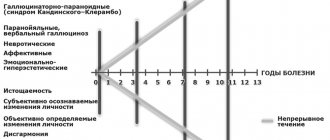The list of such pathologies includes health disorders associated with disorders occurring in the psyche. They can be triggered by social, biological or psychological factors. People who have difficulty coping with accepting the realities of real life are most often susceptible to illness. They are often unable to recover from failures that have occurred. There is some inadequacy in actions, behavior and thinking.
Psychological developmental disorders
These pathologies in ICD-10 are included in the heading F80-F89. The diseases included in it always begin in childhood, including infancy. Their development requires a delay in the development of the nervous system or its damage associated with pathological maturation. They are characterized by a constant course, there are no relapses.
The lesions affect motor functions, speech, and visual-spatial skills. In most cases, environmental factors in this pathology are important, but not decisive. At the same time, the etiology of the lesion is not precisely defined, due to which an exact determination of the causes of developmental disorders cannot be established at the moment. Today it is also common to include autistic disorders among such pathologies.
Behavioral disorders associated with physiological characteristics and physical factors
List of pathologies:
- Eating disorders: bulimia nervosa, anorexia nervosa, psychogenic vomiting, binge eating disorder, orthorexia nervosa. The disorders are characterized by loss of control over the amount of food eaten, obsessive monitoring of body weight and external attractiveness.
- Sleep disorders of nonorganic origin: insomnia, drowsiness, sleep pattern disorders, sleepwalking, nightmares.
- Inorganic sexual disorders: decreased libido, aversion to sexual intercourse, erectile dysfunction, premature ejaculation, vaginismus, increased sexual desire. These are functional disorders: they occur after a quarrel, with emotional changes, or lack of sleep.
- Mental pathologies associated with the postpartum period. Characterized by emotional and behavioral disorders after childbirth. More often – postpartum depression.
Psychological disorders treatment
Treatment of psychological disorders in patients of any age can only be prescribed by an experienced specialist. Previously, the patient undergoes a thorough health examination. It is carried out in order to exclude the possibility of the presence of a physiological disease. Passing symptoms can be provoked, for example, by endocrine or neurological disorders.
After eliminating physiological causes, the patient's psychological state is examined. An important part is collecting a family history. The fact of hereditary damage to psychological diseases has not been confirmed at the moment, but there are cases of familial predisposition. Doctors suggest that they may be associated with family habits and hereditary character traits.
The following are used in therapy:
- medications: antipsychotics, antidepressants, mood stabilizers;
- psychological classes, both individual and in groups;
- Physical therapy classes are shown.
Often patients may be advised to find an additional hobby. It can distract the patient from unpleasant thoughts.
Chronic mental disorder
In medicine, chronic disorders are usually understood as a condition of a sick person when it occurs over a long period of time and with characteristic attacks. Types of such disorders include paranoia, epilepsy, manic or depressive psychosis.
Chronic mental disorder, like most diseases of this type, is characterized by periods of improvement and sharp deterioration in a person’s condition. Even after all signs of the disease have been suppressed, the patient is left with a persistent mental defect that is difficult to treat.
Psychological personality disorders
After confirmation of the diagnosis, pathology refers to severe psychological deviations in the psychological sphere of a person’s consciousness. They are found in human popularity and are diagnosed in about 12% of the population. Disorders are more often diagnosed in males.
They are characterized by obvious violations of destructive behavior patterns. This list does not include personality disorders caused by pathologies or brain injuries.
According to ICD10, psychological disorders are divided into:
- Schizoid, characterized primarily by disturbances of contact in society, a tendency to recluse and complete isolation. Patients lack a proper sense of reality. A schizoid can be continuously busy with endless and meaningless mental work.
- Paranoid disorders accompanied by an increased level of suspicion. Patients are characterized by increased sensitivity, high ambition, and inability to accept personal failures. Over time, the severity of the reaction does not dull, but appears regularly with increasing force.
- Dissocial, characterized by a disdainful attitude towards social, personal, and everyday responsibilities.
- Emotionally unstable, in which instincts and feelings become the determining reasons for actions.
- Hysterical, in which patients are characterized by dramatization of what is happening, excessive pretense in the manifestation of feelings.
- Anankastnye, a striking feature of which is pedantry at the level of pathology. Petty scrupulousness contradicts a real love of order.
- Anxious, which is accompanied by a constant feeling of fear and personal tension. A person constantly assumes that something tragic might happen to him. Accompanied in most cases by an inferiority complex.
- Dependents, characterized by a personality’s tendency to completely subordinate to others, pathological passivity, and the inability to make adequate decisions independently.
According to ICD 10, “other disorders” include narcissism, eccentricity, infantilism, psychoneurotic and passive-aggressive disorders. Doctors also separately identify pathologies of an unspecified type.
Symptoms of a mental disorder
The World Health Organization divides the symptoms of mental disorders in humans into 4 main groups:
- Sensory-perceptual symptoms in which a person has a distortion of reality and can hear, feel or see things that others cannot sense.
- A common neurological symptom is cognitive impairment. The patient is increasingly experiencing a disorder of clear speech, memory lapses occur, and pathological beliefs about an event are established.
- Symptoms of a behavioral nature, when the patient may show unreasonable aggression towards relatives or stop performing daily functions.
- Emotional disorders most often occur as the main symptom; the patient may constantly feel a feeling of fear or sadness.
Causes of psychological disorders
The list of provoking factors may include:
- severe pregnancy in the patient’s mother;
- birth injuries;
- presence of genetic predisposition;
- severe stressful situations;
- experiences, including in childhood, of psychological or physical violence.
The presence of one or even several provoking factors at once does not guarantee the onset of a psychological disorder.
In such patients, disturbances are caused by the characterological constitution, the habitual model of behavior used, and a certain personal structure.
Emotional and behavioral disorders in children and adolescents
These include diseases that develop in children or adolescents:
- hyperkinetic disorders: disturbance of attention and activity, hyperkinetic behavior;
- pathologies of behavior: disrupted behavior in the family, impaired socialization, negativism, antisocial child behavior;
- mixed diseases: depressive syndrome, anxiety, aggressiveness, obsession or obsession, depersonalization-derealization syndrome, phobias, hypochondria.
- tics: transient, chronic, combined;
- specific disorders for childhood: night urination, lack of appetite, eating inedible substances, stereotypical movements, stuttering, speech excitedly.
Symptoms and signs of psychological disorder
At the moment, doctors are not ready to strictly define the specific symptoms and signs of a psychological personality disorder. Manifestations in each patient are strictly individual. But there are general points that suggest the need to seek advice.
According to ICD10, the main symptoms and signs include disturbances in behavioral reactions, mental activity, and actions that go beyond the recognized framework of current cultural and moral beliefs and norms. Physical, cognitive and neurological symptoms are observed. They are prone to increased levels of fatigue. They often feel excessively happy or excessively unhappy without a specific reason. Logical relationships are broken.
ICD10 calls the signs:
- spatiotemporal disorientation;
- quick and groundless changes in mood;
- inadequate attitude towards one’s own physical and emotional state;
- the appearance of hallucinations;
- cases of confusion;
- confusion;
- fright;
- lack of reaction to what is happening.
Sleep is often disturbed. This can equally manifest itself as increased levels of drowsiness and insomnia. A common trigger is depression associated with serious stress, for example, the loss of a close relative. There may be a violation of the order of self-identification. The patient creates an alternative personality that has nothing to do with what happened. The weakening of memory to the level of its complete absence is diagnosed. Mental interest is disturbed, often accompanied by delirium. In some cases, the patient suffers from bouts of unreasonable laughter or a tendency to unreasonably increased tearfulness. Doctors include alcohol and drug abuse among psychological disorders.
Signs characteristic only of men are highlighted separately. They may be associated with untidiness in appearance and violation of hygiene standards. Men experience failures especially painfully and tend to blame the entire world around them for what happened. They become irritable and tend to offend and humiliate their interlocutors.
Temporary mental disorder
Unlike a chronic disorder, a temporary one involves understanding such conditions of a sick person in which short-term mental abnormalities are observed, ultimately amenable to complete recovery.
A temporary mental disorder can manifest itself in a person in the form of delirium tremens. This pathological condition is most often caused by prolonged alcohol consumption. Temporary disorders also include severe mental states, experiences and nervous conditions caused by external environmental factors.
Diagnosis of psychological disorders
When diagnosing psychological disorders, doctors must first prescribe an examination of all body systems. This is necessary to exclude physiological causes of pathology.
Patients are prescribed ECHO, MRI, CT, and examination by an endocrinologist and neurologist is recommended. A study of the medical history is carried out. Psychological manifestations often become side effects of taking certain medications. For example, prescribed in the treatment of neurological diagnoses.
An important part of the diagnosis is a personal conversation with the patient. It is recommended to involve close relatives and those people with whom the patient is in constant contact.
Healthcare and support
Health systems are not adequately responding to the burden of mental disorders. As a result, there is a large gap between treatment needs and care provided worldwide. In low- and middle-income countries, between 76% and 85% of patients with mental disorders receive no treatment2.
The problem is further aggravated by the fact that the care offered is often of insufficient quality.
In addition to health care structures, people with mental disorders should be helped and supported by those around them. These people often need help accessing training programs tailored to their needs, finding work and housing so they can participate actively in society.
Types of psychological disorders
In modern medicine, there are several main types of psychological disorders, which differ in symptoms and types of manifestation. Often, to eliminate the disease or enter a state of stable remission, depending on the type, different treatment options are required.
Neuropsychological disorder
Differs in manifestations of destructive behavior. In most cases, it is caused by improper functioning of the brain. Stand out:
- Exogenous or external causes associated with head injuries, illnesses, chemical poisoning, psychological trauma. May be associated with disorders of the cardiovascular system, leading to impaired blood supply to the brain.
- Endogenous or internal causes, which are mostly genetic, caused by a violation in the set of chromosomes.
Due to the commonality of psychotypes, they can often be transmitted from parents to children. Among the provoking factors are some diseases, including cerebral vascular sclerosis, diabetes mellitus, cerebrovascular accidents, and infectious diagnoses. Can be triggered by taking drugs and alcohol.
Mixed developmental disorders
In ICD13 they are classified as F83. The first manifestation is most often noted in childhood or infancy. Typically associated with chromosomal or genetic disorders. Accompanied by speech and school skills impairments. Motor functions may be impaired. They are diagnosed only in the case of a complete combination of several psychological disorders aggravated by life circumstances.
Specific psychological development disorder
Today, this category of pathological disorders has been poorly studied. An accurate diagnosis is complicated by the unreasonable combination of violations of the proper and timely acquisition of language skills, accompanied by motor disorders. But it is not recognized as intellectual retardation as such.
Mixed specific psychological development disorders
They are also established in the case of a combination of several factors recognized in the ICD10. Verbal intelligence suffers, and there are disturbances in the development of speech functions. There may be cases of disorientation and problems with logic are identified. Memory suffers.
Substance use disorders
This includes mental illnesses that occur after taking alcohol, opioid drugs, cannabinoids, sedatives and hypnotics, cocaine and psychostimulants, hallucinogens, tobacco and volatile solvents. This includes many syndromes and pathological conditions. Here are the main types:
Acute intoxication. Usually characterized by nausea, vomiting, impaired consciousness, disorientation, headache, and autonomic disorders.
Withdrawal syndrome. Characterized by complex mental disorders after a long break from taking psychoactive substances.
Acute psychotic disorders. Characterized by hallucinations, delusional disorders, emotional disturbances, and illness of consciousness during or after taking a psychoactive substance.
Dependency syndrome. Characterized by obsessive desires and actions to use a new dose of the drug.
Amnestic syndrome. It is characterized by severe memory impairment for distant or recent events, impaired perception of time and confabulations during or after drug use.
Psychological development disorder in a child
They are diagnosed when a child has a combination of impairments in school skills, poor speech development, and problems with motor functions. In this case, it is impossible to establish an accurate diagnosis due to the lack of predominance of one of these disorders.
Additionally, a certain level of cognitive impairment is detected. The disadvantage of diagnosis is the frequent use of diagnosis in the absence of a real opportunity to establish the exact cause and the leading predominant factor. Often such children are diagnosed with mental retardation. An important condition is the identification of the first signs of pathology at a very early, often infancy, age.
The leading causes are called biological factors. Including minor tissue damage to brain structures, which provoked a disruption in the formation of interanalyzer connections.
An additional provocateur is the lack of information associated with the low family level. Manifestations include:
- speech disorder dyslexia;
- dysgraphia, which manifests itself in the occurrence of problems with the development of written speech skills;
- dyscalculation disorders.
Such children should be under constant supervision of a psychiatrist. The course of treatment includes psychotherapy sessions and drug therapy. It is difficult for children to master the curriculum of a secondary school. They successfully master the rules of acquiring school skills in Type VIII schools. Although such a translation is recommended only in situations where the level of pathology is on the same level as mental retardation.
There is a clear trend towards a decrease in the level of impairments in adolescence; often the pathology can eventually be smoothed out completely, but problems with cognitive efficiency can remain in adulthood.
Schizophrenia and other psychoses
Schizophrenia is a severe mental disorder that affects 20 million people worldwide1. Psychoses such as schizophrenia are characterized by distorted thinking, perception of the world and self, emotions, speech and behavior. Common psychotic symptoms include hallucinations (hearing, seeing, or feeling things that are not there) and delusions (persistent false beliefs or suspicions that persist even in the face of evidence to the contrary). People with these disorders may have difficulty working and learning.
Lack of access to health and social services can result in stigma and discrimination. In addition, people suffering from psychosis are at high risk of human rights violations, for example, during long-term institutionalization.
Schizophrenia typically develops in late adolescence or early adulthood. There are effective drug treatments combined with psychosocial support. With proper treatment and social support, patients can lead productive lives and integrate into society. Assistance and care in activities of daily living, housing and employment support can provide the foundation on which people with severe mental disorders, including schizophrenia, can achieve multiple recovery goals, as they often have difficulty obtaining or maintaining normal employment.
Major psychological disorders
Currently, experts suggest that by 2021, psychological disorders may take fifth place in the list of diseases leading to disability. According to Russian doctors, pathologies can be diagnosed in at least every resident of modern Russia. Approximately similar levels of indicators are observed in all developed countries of the world.
All the reasons for the occurrence of such pathologies are not known to modern doctors today. Conducted research shows that the list of provocateurs may equally include genetic predisposition and external life events. Diseases of the nervous system, leading to psychological pathologies, are caused by all factors that disrupt the activity of the central nervous system.
Despite the inability to identify the exact cause of the onset of psychological disorders, these pathologies can now be successfully treated. Depending on the degree of damage, treatment uses only courses of psychotherapy or medications, including antipsychotics and antidepressants.
Currently, psychiatrists are highlighting an increase in the number of confirmations of diagnoses of depressive disorders and phobias. They can often be accompanied by bipolar disorder.
The danger of each of these diagnoses is a violation of the patient’s socialization. Even a violation at the mildest level leads to a decrease in the level of performance. Patients become socially isolated. They often prefer loneliness and family ties are disrupted. Pathology leads to the appearance of suicidal thoughts.
Another large group is fears. They are established whenever a level of panic is detected in the perception of objects, natural phenomena, or events. Modern man often becomes pathologically afraid of spiders, the dark, water, and some animals. The reason can actually be any factor. Moreover, in such a situation, fear is not caused by a natural sense of self-preservation. It is inexplicable and appears unreasonably. The concern is that in reality there is no threat to health, much less life.
The number of diseases associated with unreasonable feelings of fear is incredibly large. Many of us also encounter their manifestations during rush hour in a subway car or in a large chain store. The crowds of people that surround us here are unpleasant even for healthy people. But it is not rejection that speaks of pathology, but rather fear at the level of a panic attack, in which the patient may begin to choke and may faint.
The list of major pathological disorders includes alcohol and drug addiction, bulimia, anorexia, and obesity. Doctors often encounter pathological sleep disorders.
Who is at risk for mental disorders?
Determinants of mental health and mental disorders include not only individual qualities, such as the ability to manage one's own thoughts, emotions, behavior and communication with others, but also social, cultural, political and environmental factors, such as national policies, social protection, living standards, conditions work and support of others.
Stress, heredity, nutrition, perinatal infections and environmental exposures can also cause mental disorders.
Psychological disorders list
This list is currently incredibly wide, but experts identify the largest groups:
- Alcohol addiction, caused by a pathological passion for drinking alcoholic beverages, often caused by a violation of social adaptation. This also includes drug addiction. Admission leads to persistent mental disorders.
- Schizophrenia, in which the patient most often experiences perceptual disturbances. Often accompanied by fantastic delusions and hallucinations.
- Pathologies of the brain, most often first manifested in childhood, sometimes in adolescents, the pathology intensifies as they grow older.
- Disorders that occur in the emotional sphere, often called affective disorders. This section includes bipolar disorder, which is increasingly being diagnosed today.
- Neuroses and numerous variants of phobias that arise from a combination of internal and external conflicts.
- Physiological disorders associated with pathologies of eating, sexual, labor, and sleep dysfunction.
- Disorders that occur in adults are associated with pathological conditions in the field of social adaptation, and there is a lack of development in the emotional sphere. Patients often deny the presence of problems and refuse any medical care options.
- Cases of mental retardation. In such a situation, all areas of life suffer, the patient needs constant monitoring, and is almost always unable to care for himself.
In the modern world, everyone can sometimes suspect one or another type of psychological illness. But an accurate diagnosis can only be established in a medical institution by a qualified doctor. If you suspect the presence of a pathology, it is recommended to immediately contact a specialist.
Acute mental disorders
Transient and acute psychotic personality disorders are characterized by the most rapid development of diseases. The condition of a sick person can deteriorate significantly in just a few days, with several main signs observed - depression and passive mood, accompanied by intense hallucinations, states of seizures and delirium.
Acute mental disorders are conventionally divided into two categories - polymorphic state and schizophrenia. The latter occurs most often, the true causes of which have not yet been established. The risk group may include people who have been subjected to severe violence (not necessarily of an intimate nature), as well as those who have experienced severe emotional stress.
PsyAndNeuro.ru
We are publishing the following descriptions of changes to the ICD-11 chapter on mental, behavioral and neurodevelopmental disorders. This part describes changes in the following groups: dissociative disorders, eating and feeding disorders, personality disorders, desire disorders, neurocognitive disorders, etc.
The February issue of World Psychiatry Journal, which described the main changes in ICD-11, was translated by the Council of Young Scientists of the Russian Society of Psychiatrists. Changes in other chapters can be found by following the link.
Dissociative disorders
The ICD-11 group of dissociative disorders corresponds to the dissociative (conversion) disorders in ICD-10, but has been significantly reorganized and simplified to reflect recent empirical evidence and to improve clinical utility. The reference to the term "conversion" has been removed from the group name. Dissociative disorder with neurological symptoms in ICD-11 is conceptually consistent with dissociative movement and sensation disorder in ICD-10, but is presented as a single disorder with twelve subtypes distinguished based on predominant neurological symptoms (visual impairment, non-epileptic seizures, speech impairment, paralysis or weakness etc.).
In ICD-11, dissociative amnesia includes dissociative fugue as a qualifying parameter, while in ICD-10 it was distinguished as a separate disorder. ICD-11 has divided trance and possession disorder (ICD10) into two different diagnoses: trance disorder and possession disorder. This division reflects the hallmark of possession disorder, in which, during possession, the habitual sense of self-identity is replaced by a sense of an external personality invoked by the influence of some spirit, force, deity, or other spiritual entity. Additionally, obsession disorder may describe a wider range of behavior, whereas trance disorder is usually limited to a small repertoire of simple actions.
Dissociative identity disorder in ICD-11 follows the ICD-10 concept of multiple personality disorder and has been renamed to be consistent with the nomenclature currently used for clinical and research purposes. ICD-11 also introduced partial dissociative identity disorder, reflecting the fact that ICD-10 is dominated by unspecified dissociative disorders in which non-dominant personality states periodically do not fully assume control of the individual's consciousness and functioning. Depersonalization and derealization disorder, localized in ICD-10 in the group of other neurotic disorders, was moved to the dissociative group in ICD-11.
Eating and feeding disorders
The ICD-11 grouping of eating and feeding disorders combines the ICD-10 groups of eating disorders and childhood feeding disorders, recognizing the interrelationship of these disorders across the lifespan, and also reflecting evidence that these disorders may apply to individuals over a wider age range.
ICD-11 provides an updated understanding of anorexia nervosa and bulimia nervosa and includes the latest data, eliminating the need for the “atypical” category from ICD-10. It also includes new types of binge eating disorders, which are based on empirical support for validity and clinical utility, and ARFID (avoidant or restrictive eating disorder), which includes the ICD-10 diagnosis of feeding disorder of infancy and childhood.
Anorexia nervosa in ICD-11 removes the ICD-10 requirement for the presence of a widespread endocrine disorder, since evidence suggests that this does not occur in all cases and, even if present, is a consequence of low body weight rather than a characteristic feature of the disorder . In addition, cases without endocrine disorders were a common reason for the diagnosis of atypical anorexia. The threshold for low body weight in ICD-11 has been raised from 17.5 kg/m² to 18 kg/m², but the recommendations take into account situations in which body mass index may not adequately reflect clinical deterioration (for example, sudden weight loss in the context of other features of the disorder ). Anorexia nervosa does not require “fat phobia” as in ICD-10 to provide a full range of culturally diverse rationales for food refusal and body image preoccupation.
The criteria are designed to characterize the severity of underweight, recognizing that a significantly reduced body mass index is associated with an increased risk of morbidity and mortality. The criteria allow us to describe patterns of behavior (restrictive and purifying).
ICD-11 bulimia nervosa can be diagnosed regardless of a person's current weight, as long as the body mass index is not so low as to meet the criteria for anorexia nervosa. In place of the minimum frequency criterion for binge eating, which is not supported by evidence, ICD-11 provides more flexible guidance. The diagnosis of bulimia nervosa does not require "objective" binge eating and can be diagnosed based on "subjective" binge eating, in which the person eats more or differently than usual and experiences a loss of control over eating accompanied by distress, regardless of the amount of food actually eaten . This change is expected to reduce the number of unspecified eating and feeding disorder diagnoses.
Elimination disorders
The term "inorganic" has been removed from the ICD-11 group of elimination disorders, which include enuresis and encopresis. These disorders are differentiated from those that may be better explained by another health condition or physiological effects of substances.
Disorders related to bodily self-awareness and bodily discomfort
The group of disorders associated with bodily self-awareness and bodily discomfort in ICD-11 contains two disorders: bodily discomfort and dysphoria of the integrity of the perception of one’s own body. Bodily discomfort disorder ICD-11 replaces the somatoform disorders of ICD-10, and also includes the concept of neurasthenia from the ICD. Hypochondriasis (ICD-10) is not included in this group, but is in the OCRD group. Body discomfort disorder is characterized by the presence of bodily symptoms that cause pain to the person and an excessive focus on the symptoms, which may manifest itself in repeated contact with health care professionals.
Disorders can vary in severity and are categorized accordingly (mild, moderate or severe) depending on the impact on functioning. It is important to note that body discomfort disorder is defined according to the presence of important features such as distress and excessive thoughts and behaviors, rather than based on the lack of medical explanations for bothersome symptoms, as with ICD-10 somatoform disorders. ICD-11 introduced a new diagnosis that is part of this group - dysphoria of the integrity of perception of one’s own body.
Substance use and addictive behavior disorders
The ICD-11 group of substance use and addictive behavior disorders covers disorders that develop as a result of the use of psychoactive substances, including drugs, as well as addictive behavior disorders that develop as a result of certain repetitive behaviors with reward and reinforcement. The organization of ICD-11 for substance use disorders is consistent with the approach of ICD-10, which classifies clinical syndromes according to classes of substances.
At the same time, the list of substances in ICD-11 has been expanded to reflect the current availability and use of substances. Each substance or class of substance may be associated with mutually exclusive primary clinical syndromes: a single harmful substance use or harmful substance use pattern that is a refinement of the ICD-10 diagnosis of harmful use, and substance dependence. Substance intoxication and withdrawal may be diagnosed on the basis of clinical manifestations or asymptomatic substances (as a reason for presentation to a health care provider when the pattern of use or dependence cannot be determined). Given the extremely high global burden of disease associated with substance use, this group has been revised to optimally provide health information that will be useful in a variety of contexts, including accurate monitoring and reporting, and to be useful for both prevention and for treatment.
The addition of a single episode of harmful substance use to ICD-11 provides an opportunity for early intervention and prevention of escalation of use and harm, and diagnoses of harmful substance use and drug dependence suggest the need for increasingly intensive interventions. ICD-11 expands the concept of health harm resulting from substance use to include harm to the health of others, which can include either physical harm (for example, from drunk driving) or psychological harm (for example, the development of PTSD after a car accident ).
ICD-11 includes substance-induced mental disorders as syndromes characterized by clinically significant mental or behavioral symptoms similar to those of other mental disorders, but resulting from substance use. Substance use disorders may be associated with substance intoxication or withdrawal, but the intensity or duration of symptoms significantly exceeds those characteristic of substance intoxication or withdrawal. ICD-11 also includes categories of hazardous substance use that are not classified as mental disorders but are found in the chapter “Factors influencing health status or contact with health services.”
These categories may be used when the pattern of substance use increases the risk of harmful effects on the physical or mental health of the user or others to such an extent that it requires the attention and advice of health care providers, but no obvious harm has yet occurred. They are intended to communicate opportunities for early and brief intervention, particularly in primary care settings. The ICD-11 section on addictive behavior disorders includes two diagnostic categories: gambling disorder (pathological gambling in ICD-10) and gambling disorder, which was recently introduced.
In ICD-10, pathological gambling was classified as a disorder of habits and impulses. However, recent evidence points to important phenomenological similarities between addictive behavior disorders and substance use disorders, including their higher co-occurrence rates as well as a common pattern of being initially pleasurable and then progressing to loss of pleasure and require more active use. In addition, substance use disorders and addictive behavior disorders appear to share similar neurobiology, particularly activation and neuroadaptation in neural circuits involved in reward and motivation.
Impulse control disorders
Impulse control disorders in ICD-11 are characterized by a repeated failure to resist a strong impulse, urge, or urge to perform an act that brings satisfaction to the individual, at least in the short term, despite long-term harm to both the subject and others. This group includes pyromania and kleptomania, which were classified in the ICD-10 as habit and impulse disorders. ICD-11 added intermittent explosive disorder to the group of impulse control disorders and renamed excessive sexual desire (ICD-10) to compulsive sexual behavior disorder.
Defiant and dissocial behavior disorders
In ICD-11, the group of defiant and dissocial behavior disorders replaced the ICD-10 behavior disorders. The new term better reflects the full spectrum of severity of behavior and phenomenology observed in the two conditions included in this group: oppositional defiant disorder and conduct-dissocial disorder. An important change made in ICD-11 is that both disorders can be diagnosed throughout life, whereas ICD-10 interprets them as childhood disorders. In addition, ICD-11 introduces clarifying categories that characterize subtypes of defiant and dissocial behavior disorders, intended to improve clinical utility, for example, prognostically.
Oppositional defiant disorder ICD-11 is similar to its equivalent ICD-10 category. However, the qualifying category “with chronic irritability and anger” has been added to characterize these manifestations of the disorder as having a predominant, persistent irritable mood or anger. This form has been shown to significantly increase the risk of developing depression and anxiety. The ICD-11 approach to the manifestations of oppositional defiant disorder is consistent with current evidence and differs from the approach of DSM-5, which introduced the new defiant mood dysregulation disorder.
Conduct disorder in ICD-11 combines the three separate conduct disorder diagnoses classified in ICD-10 (family-limited, unsocialized, and socialized). ICD-11 recognizes that challenging behavior and dissocial disorders are often associated with problematic psychosocial environments and psychosocial risk factors such as peer rejection, deviant peer group influence, and parental mental disorder. Clinically significant differences between childhood and adolescent onset of a disorder can be indicated using qualifying categories because there is evidence that earlier onset is associated with more severe pathology and a worse course of the disorder.
A qualifying category for limited prosocial emotions can be used in both defiant and dissocial disorders. In the context of a diagnosis of oppositional defiant disorder, these manifestations are associated with more persistent and severe oppositional behavior. And in the context of dissocial conduct disorder, limited prosocial emotions are associated with a tendency toward more severe, aggressive, and persistent antisocial behavior.
Personality disorders
Problems with the ICD-10 classification of ten specific personality disorders included significant underdiagnosis regarding their prevalence among people with other mental disorders, the fact that only two of the specific personality disorders (emotionally labile personality disorder, borderline personality disorder, and dissocial personality disorder) were reported with any frequency in public databases, and that co-occurrence rates were extremely high, the majority of people with severe disorders met criteria for multiple personality disorders.
The ICD-11 CDDG asks the clinician to first determine whether the clinical picture meets the general diagnostic criteria for a personality disorder. The physician then determines the degree of disorder (mild, moderate or severe) based on: a) the degree and prevalence of disturbances in the functioning of aspects of the personality (stability and consistency of personality, self-esteem, adequacy of self-perception, ability to self-control); b) the degree and prevalence of interpersonal dysfunctions (understanding others' points of view, developing and maintaining close relationships, conflict management) in different contexts and relationships; c) prevalence, severity and chronicity of emotional, cognitive and behavioral manifestations of personality dysfunction; d) the extent to which these patterns are associated with distress or psychosocial impairment. Personality disorders are then further described with characteristic maladaptive personality traits.
They include five domains: negative affectivity (the tendency to experience a wide range of negative emotions); detachment (the tendency to maintain social and interpersonal distance from others); dissociality (ignoring the rights and feelings of other people, including egocentrism and lack of empathy); disinhibition (the tendency to act impulsively in response to immediate internal or external stimuli without considering longer-term consequences); anacastism (a narrow emphasis on a standard of perfection, right and wrong, and on ensuring that one's own and others' behavior fully conforms to these standards). As part of the diagnosis, multiple domains may be assigned simultaneously that are considered salient and contribute to the personality disorder and its severity. In addition, an optional qualifying category is given to be used for the "template boundary". This category is intended to provide continuity of care during the transition from ICD-10 to ICD-11 and may enhance clinical utility by making it easier to identify people who may be responsive to specific psychotherapeutic treatments.
Additional research will be required to determine whether it provides information that differs from that presented in the personality trait domains. ICD-11 also includes a category of personality difficulties that are not considered mental disorders but are listed under interpersonal problems in the chapter “Factors Affecting Health Status or Contacts with Health Services.” Personality difficulties are defined as significant personality characteristics that may affect treatment or health care services but do not exceed the level of severity to warrant a diagnosis of a personality disorder. A more detailed analysis can be read at the link.
Desire disorders
The group of desire disorders in ICD-11 has been introduced to replace the group of disorders of sexual preference in ICD-10, which corresponds to modern terminology used in scientific and clinical settings. The main feature of desire disorders is that they involve patterns of sexual arousal that are directed toward the non-consent of others.
Desire disorders in ICD-11 include exhibitionistic, voyeuristic and pedophilic disorders. New categories of urge disorders include compulsory sadistic sexual disorder, frottage disorder, and other paraphilic disorder involving nonconsenting individuals. The new category of other paraphilic disorders includes behavior alone or with the consent of included individuals who have consented to sexual thoughts, fantasies, urges, or behavior involving significant distress (threats of refusal or fear of refusal are not included), or pose a direct risk of injury or death ( for example, asphyxophilia). ICD-11 distinguishes between conditions that are relevant to public health and clinical psychopathology and conditions that simply reflect private behavior. For this reason, the ICD-10 categories of sadomasochism, fetishism, and fetishistic transvestism have been eliminated.
Factitious disorders
ICD-11 introduces a new group of factitious disorders that includes self-imposed factitious disorder and factitious disorder delegated to another. This group is conceptually equivalent to the ICD-10 diagnosis of intentionally causing or feigning symptoms, or a physical or psychological disability (false impairment), but is expanded to include a clinical situation in which an individual feigns, falsifies, or intentionally stimulates or aggravates psychological or behavioral symptoms and symptoms in another person (usually a child). These behaviors are not motivated by obvious external rewards or incentives, and on this basis they are distinguished from malingering, which is not classified as a mental, behavioral or neurodevelopmental disorder, but rather falls under the chapter “Factors influencing health status or contact with health services.” "
Neurocognitive disorders
Neurocognitive disorders in ICD-11 are acquired conditions characterized by a primary clinical deficit in cognitive functioning, and include most of the conditions that were classified as organic, including symptomatic, mental disorders in ICD-10. Thus, the group includes delirium, mild neurocognitive disorder (called mild cognitive impairment in ICD-10), amnestic disorder, and dementia. Delirium and amnestic disorder can be classified as being caused by another medical condition classified elsewhere, caused by a substance or drug, or several etiological factors. Dementia can be classified as mild, moderate or severe.
Syndromic characteristics of dementia associated with different etiologies (eg, dementia due to Alzheimer's disease, dementia due to human immunodeficiency virus) are classified and described in the chapter on mental, behavioral and neurodevelopmental disorders, while the underlying etiologies are classified using categories from the chapter on diseases of the nervous system or other sections of the ICD, as appropriate. Mild neurocognitive disorder may also be identified in conjunction with an etiological diagnosis, reflecting improved methods for detecting early cognitive decline, providing an opportunity to provide treatment to delay disease progression. Thus, ICD-11 clearly describes the cognitive, behavioral and emotional components of neurocognitive disorders, as well as the causes that underlie them.
Translation into Russian was organized by the Council of Young Scientists of the Russian Society of Psychiatrists with the support of the World Psychiatric Association.
Support us by subscribing to Patreon
Translation: Pikirenya V.I. (Minsk)
Editor: Ph.D. Reznikov M.K. (Voronezh)
Source: Reed GM, First MB, Kogan CS, et al. Innovations and changes in the ICD-11 classification of mental, behavioral and neurodevelopmental disorders. World Psychiatry
. 2019;18(1):3–19. doi:10.1002/wps.20611
F30-F39 MOOD DISORDERS (AFFECTIVE DISORDERS)
This block includes disorders in which the main disorder is a change in emotions and mood towards depression (with or without anxiety) or towards elation. Changes in mood are usually accompanied by changes in overall activity level. Most other symptoms are secondary or easily explained by changes in mood and activity. Such disorders most often tend to recur, and the onset of an individual episode can often be associated with stressful events and situations.
More details








